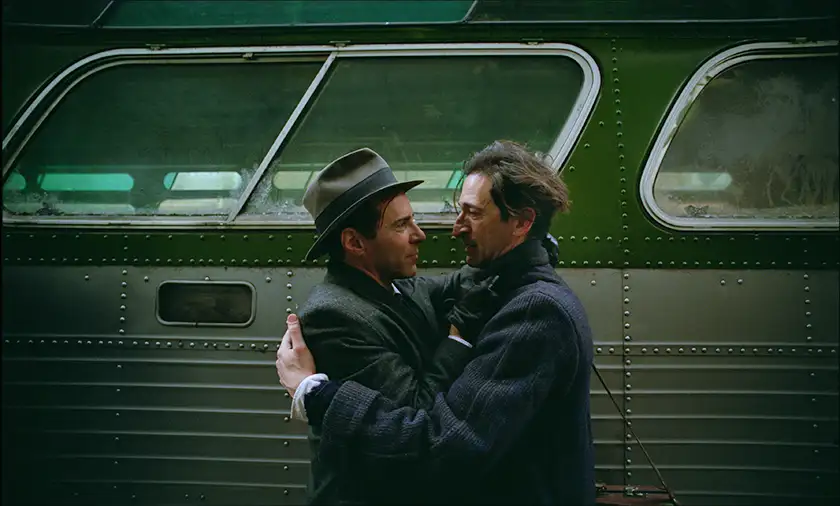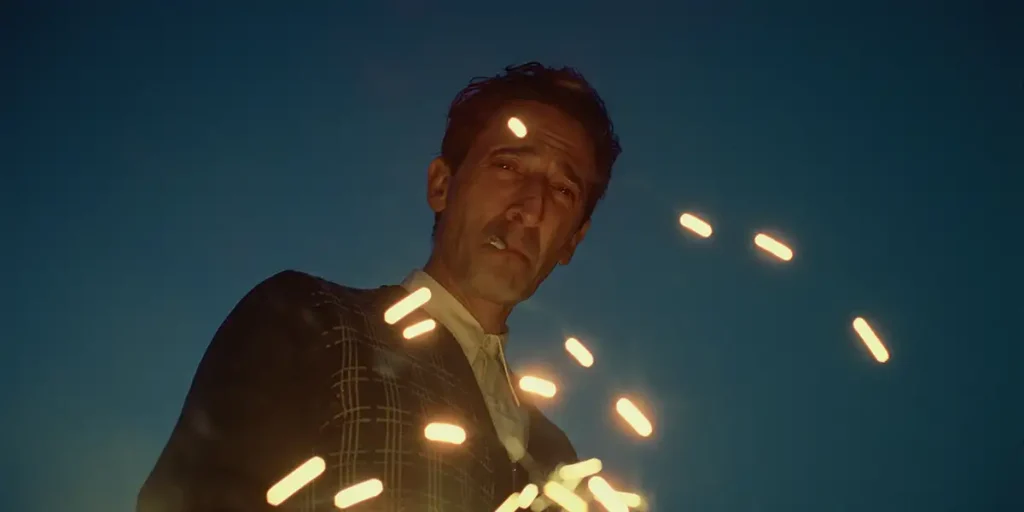The Brutalist is a masterful and exciting film that recounts history through the personal story of a brilliant and tormented man.
Writer-Director: Brady Corbet
Genre: Drama
Run Time: 215′
Venice World Premiere: September 1, 2024
U.S. Release Date: December 20, 2024 in theaters
U.K. Release Date: January 24, 2025
“Is there a better description of a cube than that of its construction?” says the protagonist of The Brutalist when asked about his passion for architecture. In narrating the life of a fictional famous Hungarian architect (although the movie is inspired by some real-life people and events), the film chooses to do exactly this: show the viewers the construction of his works rather than the buildings themselves, taking us back in time to explore the 1950s in the United States, both visually and thematically.
In true old Hollywood fashion, The Brutalist begins with an overture and introduces us to the main character, László Tóth (Adrien Brody, of Blonde) an architect who emigrates to the United States after the end of the Second World War.
The film begins in 1947, when László arrives in New ), László will try anything to reunite with her and his niece (Raffey Cassidy, of Vox Lux) with Erzsébet ‘s narration taking us through the opening scene of The Brutalist. Audiences witness every trial and tribulation László goes through, from the humble beginning in the United States, when he lives in poverty despite his already established work as an architect in Europe, to the beginning of his success across the ocean, thanks to his encounter with the wealthy Harrison Lee Van Buren (Guy Pearce, of The Convert).
The film never fails to remind us of its status as a historical drama. László’s personal history is at the very heart of his work. It is a painful story that László himself avoids reminiscing about, but it informs his work nonetheless, in a way that we only truly understands in the final scene of the film. In many ways, his works speak for him. László analyses every detail – from the material to the height of the ceilings – of his buildings and through their construction, the audience too is able to share his wonderful vision. The Brutalist also allows us to live through a very significant historical time in the United States through its main character: by telling a personal story, Cobet portrays history.

Interestingly, the film is not only on László and his work as an architect but also focuses on the entire world around him, truly entering the real of an epic historical drama. In fact, The Brutalist begins – and also ends – with a medium close-up of his niece and a voiceover letter from his wife. While he may be the main character, the people around him – especially his family and those he works with – are just as important to the story as László is. Although some have more screen time than others, every character in the film is incredibly well-explored and compelling to watch. This is also thanks to some very impressive performances, especially by Felicity Jones and Raffey Cassidy. But it is Adrien Brody who steals the movie: he is incredible as the main character, delivering what may very well be one of the best performances by a leading actor of the year.
In many ways, the film almost works like a time machine, not only when it comes to the costumes and production design, but also in its very aesthetics. The Brutalist plays with visual style, innovating the language of cinema with its bold and daring choices. Seeing it in 70mm is also an experience like no other: as the film reel gets changed in the projection room, it delivers its unique and masterful work. With its musical overture, intermission after the first half, and cinematic techniques, it re-creates the 1950s through the film medium as well.
With its focus on a Jewish immigrant who escaped the Holocaust, The Brutalist also offers a poignant reflection on racism and discrimination in the United States. László’s insistence on using his actual name, rather than changing it to its English equivalent as many of his family members end up doing, is a powerful statement. It also comments on the rest of American culture at large, delivering a significant and cut-throat criticism of the myth of the American dream. The white, educated, and American van Buren family may embody it – after all, they have been able to turn their luck around and obtain a better life through hard work – but will the same principle apply to a Jewish immigrant whose accent in English is often ridiculed?
Admittedly, The Brutalist is anything but a short film: while this might seem daunting for the audience and was certainly a challenge from a filmmaking point of view, Cobet nails it. There is no shot or moment in its runtime exceeding three hours that feels superfluous or like it could have been cut. The film is perfectly paced from its opening scene to its credits with excellent editing that makes its runtime feel a lot shorter than what it is.
Before watching The Brutalist, I was hesitant to commit to a 3-hour-and-27-minutes long film about the life of an architect whose life I knew very little about and whose works I was not entirely familiar with. And yet, the movie managed to capture my attention from its very first shot and never let it go. If László let his work speak for him more often than not as the film suggests, the same could be said for Cobet, who delivers a masterful historical drama that can rival many of the films we now consider classics.
The Brutalist had its World Premiere at the Venice Film Festival on September 1, 2024 and was released on December 20, 2024 in US theaters. The film will be distributed by Universal Pictures in the UK and Ireland, where it will be out in cinemas on January 24, 2025. Read our review of Riefenstahl!

